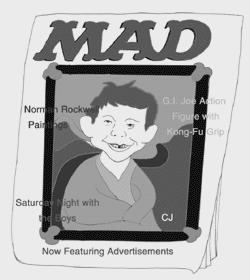|
Commercialism
comes to MAD By
Jack Bullion A couple of weeks ago, I experienced a mini-apocalypse in the magazine section at Barnes and Noble. I was standing there, arms crossed, considering my choices, when all of a sudden a magazine emblazoned with three familiar letters caught my attention — MAD! Greedily and shamelessly I snapped up the issue. I hadn’t read MAD in years, but MAD readers never outgrow their obsession. Just the fact that they read MAD renders them intellectually stunted for life. And I wasn’t really looking for a belly laugh either, knowing full well that MAD hadn’t been truly funny since the mid-1980s. I didn’t care. MAD’s like that crazy friend you try and leave behind, but are always checking up on, if only to make sure they haven’t ended up behind bars. As usual, the magazine was crammed with the customary lame jokes and groan-inducing puns. But I nearly dropped the magazine when I realized that several “articles” (if you could ever call anything in MAD an article) were in color, not in the lean, economical black-and-white comic style MAD readers had grown so used to. The only color was usually on the front and back covers. But in this issue, a spoof of “Malcolm in the Middle” (subtly re-titled “Malcontent in the Middle”) and numerous other satirical pieces had broken free of their black-and-white shackles. About midway through it, I came across an “ad” for a video game called “Portal Runner.” Immediately I began scanning the ad for a punch line, because this was quite obviously a take-off of Lara Croft and the Tomb Raider series. Wasn’t it? I felt the sweat beads start to form on my brow as the agonizing realization began to set in. MAD’s ironic, to be sure, but they’d never do something this ironic. A fake ad without an apparent punch line? It was either pure brilliance, or… a real advertisement. MAD, with ads? Bad! MAD has seldom ever featured advertisements, and certainly not in the last 30 years. Fake advertisements, however, were never in short supply, lampooning everything from smarmy Norman Rockwell paintings (“Saturday Night with the Boys” portrayed rosy-cheeked neo-Nazis out on the town) to action figures (G.I. Joe in the “don’t ask, don’t tell” era — I shouldn’t even have to explain how it looked). Serious, straightforward ads were unfathomable for a magazine that had created a legacy of taking nothing seriously. Until now, apparently. Had I been paying attention to the news, I wouldn’t have experienced such a deadening shock that day in the bookstore. The issue I’d picked up just happened to be MAD’s first foray into the worlds of color and commercialism. Apparently the two were a package deal. Without the color, there wouldn’t be any ads for “Portal Runner” or some weird band called “Finger Eleven” (a name ripe for a MAD-style send-up); MAD needed the ads to pay for their transition into something a little more colorful than pencil drawings. Uh, hello? Transition? I didn’t see anything wrong with the old stuff. MAD magazine played an integral role in my wasted youth, as it did for generation after generation of smart alecks. It ran in the family: my father, an old MAD man himself, ill-advisedly expounded the merits of MAD’s 1950’s parody “Superduperman!” to me at a very young age. Soon I was hooked. Then one glorious day, my father got me a subscription to MAD. I reveled in the sacrilegious thrill I got when I brought MAD to the dinner table and destroyed the sanctity of another treasured family institution. I marveled at the snarkiness of the Letters and Tomatoes Dept., in which otherwise loyal readers got their letters skewered by some guy named “ed” who said “Fa fa fa!” a lot. I memorized “Snappy Answers to Stupid Questions” in the event I’d actually have the good fortune to use them on some poor sap one day. And for years I would carry around a copy of MAD just in case I ran into a celebrity, so I could get my picture taken with them holding the magazine, send it in, and win a free subscription. It was — well, madness. But an era is over. MAD isn’t trying to impress older readers like my father, the writers of “The Simpsons” or me anymore. My guess is that the dwindling amount of adolescent (mostly male) readership MAD retains could care less whether they see an ad for a video game or a cheesy band. But for those who grew up with “the usual gang of idiots,” our crazy friend has just bought a three-piece suit, a house in the Hamptons and a BMW. I put the magazine back on the rack, heartbroken. It’s a sad, sad, sad, sad world. Jack
Bullion is a junior English major from Columbia, Mo.
Editorial policy: The content of the Opinion page does not necessarily represent the views of Texas Christian University. Unsigned editorials represent the view of the TCU Daily Skiff editorial board. Signed letters, columns and cartoons represent the opinion of the writers and do not necessarily reflect the opinion of the editorial board. Letters to the editor: The Skiff welcomes letters to the editor for publication. Letters must be typed, double-spaced, signed and limited to 250 words. To submit a letter, bring it to the Skiff, Moudy 291S; mail it to TCU Box 298050; e-mail it to skiffletters@tcu.edu or fax it to 257-7133. Letters must include the author’s classification, major and phone number. The Skiff reserves the right to edit or reject letters for style, taste and size restrictions. |
The TCU Daily Skiff
© 1998, 1999, 2000, 2001
Web Editor: Ben Smithson
Contact Us!

